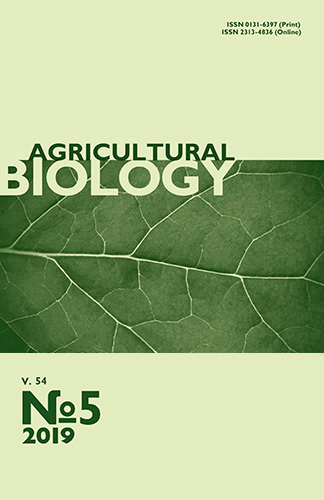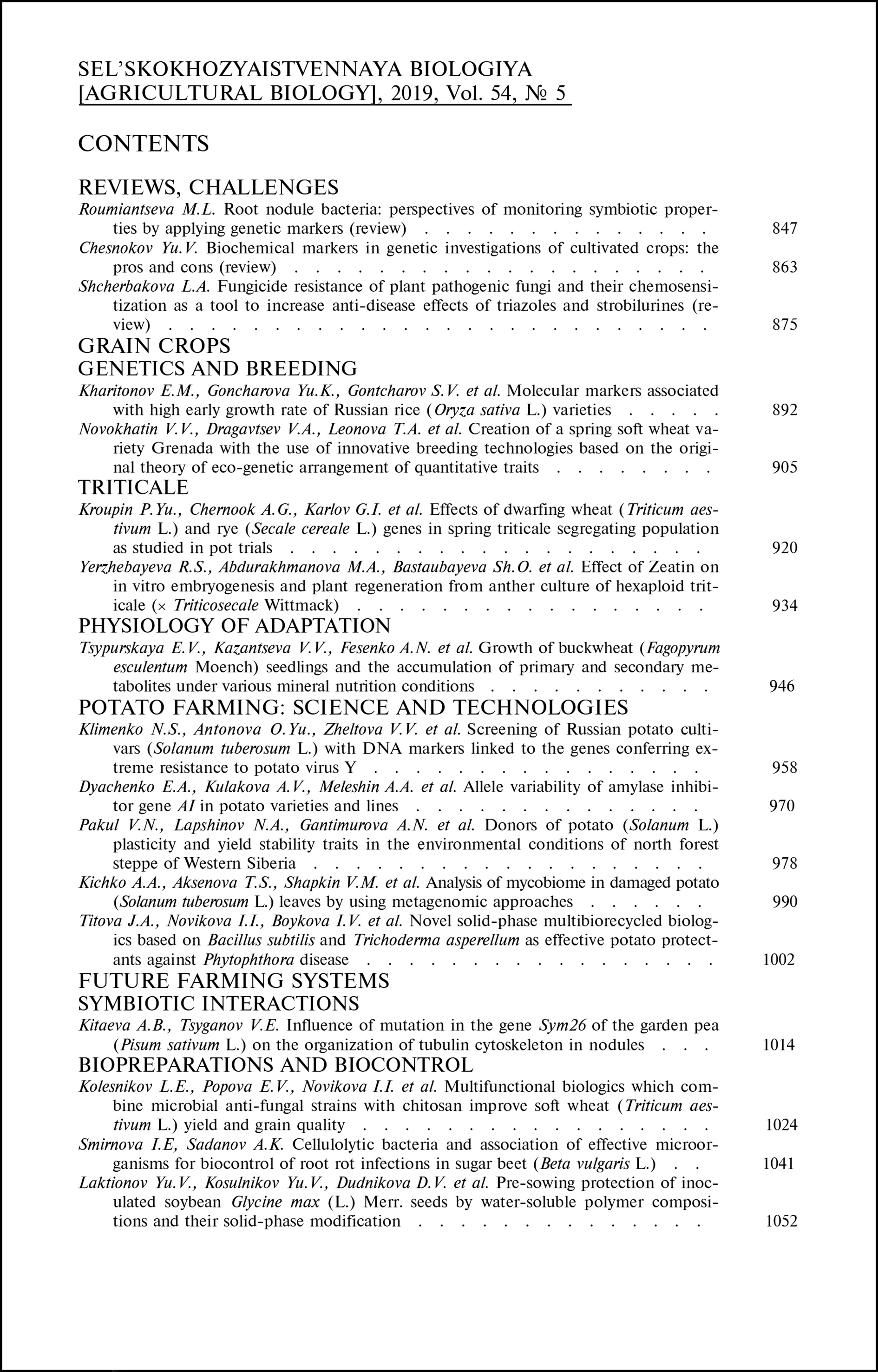doi: 10.15389/agrobiology.2019.5.892eng
UDC: 633.18:581.14:577.21
Acknowledgements:
Supported financially by Russian Science Foundation, project No. 19-16-00064
MOLECULAR MARKERS ASSOCIATED WITH HIGH EARLY GROWTH RATE OF RUSSIAN RICE (Oryza sativa L.) VARIETIES
E.M. Kharitonov1, Yu.K. Goncharova1, S.V. Gontcharov2, B.Н. Bruyako1
1All-Russian Rice Research Institute, 3, Belozernii, Krasnodar, Russia 350921, e-mail evgeniyharitonov46@mail.ru, yuliya_goncharova_20@mail.ru (✉ corresponding author), сesnokova86@mail.ru;
2Kuban State Agrarian University, 13, ul. Kalinina, Krasnodar, Russia 350044, e-mail serggontchar@hotmail.com
ORCID:
Kharitonov E.M. orcid.org/0000-0002-4049-6173
Gontcharov S.V. orcid.org/0000-0002-6317-7175
Goncharova Yu.K. orcid.org/0000-0003-2643-7342
Bruyako B.Н. orcid.org/0000-0003-0208-1548
Received September 25, 2018
The high rate during early growth is expected to be the main basis of next “green revolution”. Many researches take into account that this trait is mainly responsible for physiological advantage of heterotic hybrids in crops. The rapid development of the root system provides an advantage in absorption of mineral substances and the photosynthetic apparatus formation. Heterotic hybrids can quickly overpass the phase sensitive to stresses thereby improving the adaptability to different stress factors. Significant differences between varieties and subspecies in the growth rate of seedlings are widely used for effective breeding. The growth rate is a plant-height-related trait. Heritability of seedling height, weight, and the length of embryo root is very high (87-90 %). This paper is the first report on loci that determine the growth rate during germination period in rice (Oryza sativa L.) varieties bred in Russia. The aim of our work was to reveal effective SSR markers for chromosome loci and regions which are involved in the control of traits responsible for high rate of early growth in the Russian rice (Oryza sativa L.) gene pool. Seeds of 32 varieties bred in Russia and hybrids were surface-sterilized for 40 min with a 20 % sodium hypochlorite solution (95.2 % active Cl; ООО Grinfild RUS, Russia). Thirty grains of each sample were germinated (in duplicate) for 7 days at 28-29 °C in a thermostat. Morphophysiological parameters of 20 seedlings of each variety or hybrid, i.e. the weight, the size of coleoptile and the embryonic root formation, were measures. As per the finding of this study, the loci that determine the seedling weight are located on four chromosomes near the markers RM261, RM405, RM463, RM242, RM6314, RM289, and RM126. The embryonic root growth rate is determined by two chromosomal regions on chromosomes 4 and 9, the seedling height — by only one locus located on the chromosome 5 near the marker RM289. One can simplify identification of chromosomal regions that determine target trait values in a set of unknown varieties or hybrids. Bulk breeding methods allows markers with the maximum phenotypic effect to be identified with no need to create a population recombinant inbred lines (RILs) or double haploid lines (DH) for mapping. In particular, exploiting cultivars which are contrast in the traits of interest is much more informative. Such phenotypic analysis reveals the most important loci for the entire group of varieties tested. Next, the markers can be found which are closely linked to the genes that determine the trait in the identified chromosomal region (http://www.gramene.org). Markers that are enough polymorphic to ensure reliable separation of varieties into contrasting groups may be further used in breeding work. Not always genes, differentiating varieties by a certain trait in one region of the world will be effective for another region. Therefore, such preliminary assessment is obligatory. Thus, in this study using original technique to simplifies identification of the loci of interest we have identified 8 chromosomal regions associated with early growth rate in Russian rice varieties.
Keywords: Oryza sativa L., rice, molecular markers, genetics, growth rate, early stages of ontogenesis, seedlings, weight, height, embryonic roots.
REFERENCES
- Meyer R.C., Törjék O., Becher M., Altman T. Heterosis of biomass production in Arabidopsis. Establishment during early development. Plant Physiology, 2004, 134(4): 1813-1823 CrossRef
- Meyer R., Pospisil C.H., Scholten S. Heterosis associated gene expression in maize embryos 6 days after fertilization exhibits additive, dominant and overdominant pattern. Plant Mol. Biol., 2007, 63: 381-391 CrossRef
- Chang T.T. Manual on genetic conservation of rice germplasm for evaluation and utilization: IRRI Los Banos. Philippines, 1976: 75.
- Suge H. The genetic control of gibberellin production in rice. Jpn. J. Genet., 1976, 53: 199-207.
- Hu C.H. Evaluation of breeding semidwarf rice by induced mutation and hybridization. Euphytica, 1973, 22: 562-574.
- Alvarado-Sanabria O., Garcés-Varón G., Restrepo-Díaz H. Physiological response of rice seedlings (Oryza sativa L.) subjected to different periods of two night temperatures. Journal of Stress Physiology and Biochemistry, 2017, 13(1): 35-43.
- Science of the rice plant. Vol. 3. Genetics. T. Matsuo, Y. Futsuhara, F. Kikuchi, H. Yamaguchi (eds.). Food and Agriculture Policy Research Center, Tokyo, 1997.
- Miura K., Kuroki M., Shimizu H., Ando I. Introduction of the long-coleoptile trait to improve the establishment of direct-seeded rice in submerged fields in cool climates. Plant Production Science, 2002, 5(3): 219-223 CrossRef
- Wang Z., Wang J., Bao Y., Wu Y., Zhang H. Quantitative trait loci controlling rice seed germination under salt stress. Euphytica, 2011, 178(3): 297-307 CrossRef
- Ohsumi A., Furuhata M., Matsumura O. Varietal differences in biomass production of rice early after transplanting at low temperatures. Plant Production Science, 2012, 15(1): 32-39 CrossRef
- Fukuda A., Terao T. QTLs for shoot length and chlorophyll content of rice seedlings grown under low-temperature conditions, using a cross between indica and japonica cultivars. Plant Production Science, 2015, 18(2): 128-136 CrossRef
- Sasaki A., Ashikari M., Ueguchi-Tanaka M., Itoh H., Nishimura A., Swapan D., Ishiyama K., Saito T., Kobayashi M., Khush G.S., Kitano H., Matsuoka M. Green revolution: A mutant gibberellin-synthesis gene in rice. Nature, 2002, 416: 701-702 CrossRef
- Adachi Y., Sugiyama M., Sakagami J., Fukuda A., Ohe M., Watanabe H. Seed germination and coleoptile growth of new rice lines adapted to hypoxic conditions. Plant Production Science, 2015, 18(4): 471-475 CrossRef
- Bastawisi A.O., El-Mowafi H.F., Abo Yousef M.I., Draz A.E., Aidy I.R., Maximos M.A., Badawi A.T. Hybrid rice research and development in Egypt. In: Hybrid rice for food security, poverty alleviation and environmental protection. Proceedings of the 4th International Symposium on Hybrid Rice, Hanoi, Vietnam, 14-17 May 2002. S.S. Virmani, C.X. Mao, B. Hardy (eds.). International Rice Research Institute, Los Baños, Philippines, 2003: 257-263.
- Kostylev P.I., Vozhzhova N.N. V sbornike: Ekologicheskaya genetika kul'turnykh rastenii [In: Ecological genetics of cultivated plants]. Krasnodar, 2011: 296-299 (in Russ.).
- Goncharova Yu.K. Geneticheskie osnovy povysheniya produktivnosti risa. Doktorskaya dissertatsiya [Genetic basis for increasing rice productivity. DSc Thesis]. Krasnodar, 2014 (in Russ.).
- Goncharova Yu.K., Kharitonov E.M. On genetic and physiological mechanisms of salt resistance in rice Oryza sativa L. (review). Sel'skokhozyaistvennaya biologiya [Agricultural Biology], 2013, 3: 3-11 CrossRef (in Russ.).
- Goncharova Yu.K. Inheritance of heat resistance in rice. Russian Journal of Genetics: Applied Research, 2011, 1(3): 248-251.
- Meyer S., Scholten S. Equivalent parental contribution to early plant zygotic development. Current Biology, 2007, 17: 1686-1691 CrossRef
- Meitzel T., Radchuk R., Link W., Weber H. Molecular physiology and genetics of seed heterosis in the model Vicia faba L. Proc. International Conference on Heterosis in Plants, University of Hohenheim, Stuttgart, Germany September 7-9, 2009. Stuttgart, 2009: 32.
- Shapturenko M.N. Geneticheskaya divergentsiya i geterozis u rastenii. Doktorskaya dissertatsiya [Genetic divergence and heterosis in plants. DSc Thesis]. Minsk, 2018 (in Russ.).
- Kostylev P.I., Parfenyuk A.A., Stepovoi V.I. Severnyi ris [North rice]. Rostov-na-Donu, 2004 (in Russ.).
- Hua J.P., Xing Y.Z., Xu C.O., Sun X.L., Yu S.B., Zhang Q. Genetic dissection of an elite rice hybrid revealed that heterozygotes are not always advantageous for performance. Genetics, 2002, 162: 1885-1895.
- Wang Y., Guo Y., Hong D.-l. QTL analysis of anoxic tolerance at seedling stage in rice. Rice Science, 2010, 17(3): 192-198 CrossRef
- Wang Z., Wang F., Zhou R., Wang J., Zhang H. Identification of quantitative trait loci for cold tolerance during the germination and seedling stages in rice (Oryza sativa L.). Euphytica, 2011, 181(3): 405-413 CrossRef
- Bruyako V.N. Differentsiatsiya sortoobraztsov risa po tempam rosta i razvitiya rastenii. Kandidatskaya dissertatsiya [Differentiation of rice varieties for plant growth and development rates. PhD Thesis]. Krasnodar, 2016 (in Russ.).
- McCouch S.R., Sweeney M., Li J., Jiang H., Thomson M., Septiningsih E., Edwards J., Moncada P., Xiao J., Garris A., Tai T., Martinez C., Tohme J., Sugiono M., McClung A., Yuan L., Ahn S. Through the genetic bottleneck: O. rufipogon as a source of trait-enhancing alleles for O. sativa. Euphytica, 2007, 154(3): 317-339 CrossRef
- Matsushima K., Sakagami J. Effects of seed hydropriming on germination and seedling vigor during emergence of rice under different soil moisture conditions. American Journal of Plant Sciences, 2013, 4(8): 1584-1593 CrossRef
- Los' G.D. Sel'skokhozyaistvennaya biologiya, 1987, 2: 107-109 (in Russ.).
- Thomson M., de Ocampo M., Egdane J., Rahman M.A., Sajise A.G., Adorada D.L., Tumimbang-Raiz E., Blumwald E., Seraj Z.I., Singh R.K., Gregorio G.B., Ismail A.M. Characterizing the Saltol quantitative trait locus for salinity tolerance in rice. Rice, 2010, 3(2-3): 148-160 CrossRef
- Tyurin V.V., Shcheglov S.N. Diskriminantnyi analiz v biologii [Discriminant analysis in biology]. Krasnodar, 2015 (in Russ.).
- Dragavtsev V.A., Tsil'ke P.A., Reiter V.G., Vorob'ev V.A., Dubrovskaya A.G., Korobeinikov N.I., Novokhatin V.V., Maksimenko V.P., Babakishiev A.G., Ilyushchenko V.G., Kalashnik N.A., Zuikov Yu.P., Fedotov A.M. Genetika priznakov produktivnosti yarovykh pshenits v Zapadnoi Sibiri [Genetics of spring wheat productivity traits in Western Siberia]. Novosibirsk, 1984 (in Russ.).
- Gramene: A comparative resource for plants. Available http://www.gramene.org. Accessed 20.10.2018.
- Zhang S., Zheng J., Liu B., Peng S., Leung H., Zhao J., Wang X., Yang T., Huang Z. Identification of QTLs for cold tolerance at seedling stage in rice (Oryza sativa L.) using two distinct methods of cold treatment. Euphytica, 2014, 195(1): 95-104 CrossRef
- Verma S.K., Xalxo M.S., Saxena R.R., Verulkar S.B. Identification of QTLs for cold tolerance at seedling stage in rice (Oryza sativa L.). Indian Journal of Genetics and Plant Breeding, 2014, 74(1): 86-89 CrossRef
- Xie L., Tan Z., Zhou Y., Xu R., Feng L., Xing Y., Qi X. Identification and fine mapping of quantitative trait loci for seed vigor in germination and seedling establishment in rice. Journal of Integrative Plant Biology, 2014, 56(8): 749-759 CrossRef
- Singh B.K., Singh A.K., Meetei Ng.T., Mukherjee A., Mandal N. QTL mapping for cold tolerance at the seedling stage in rice. International Journal of Bio-resource and Stress Management, 2016, 7(5): 1214-1224 CrossRef
- Goncharova J.K., Gontcharov S.V., Chicharova E.E. Localization of chromosome regions controlling high photosynthetic potential in Russian rice cultivars. Russian Journal of Genetics, 2018, 54(7): 796-804 CrossRef












